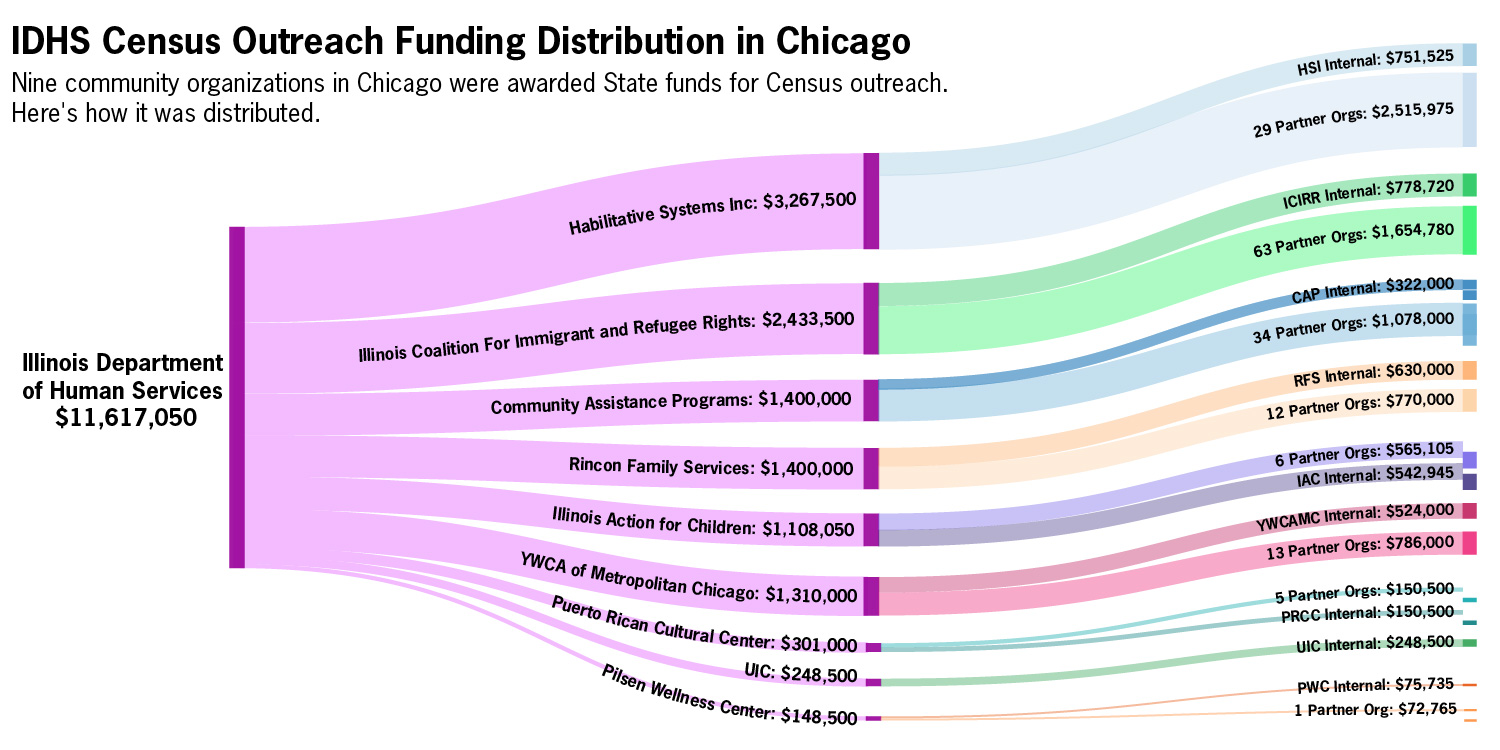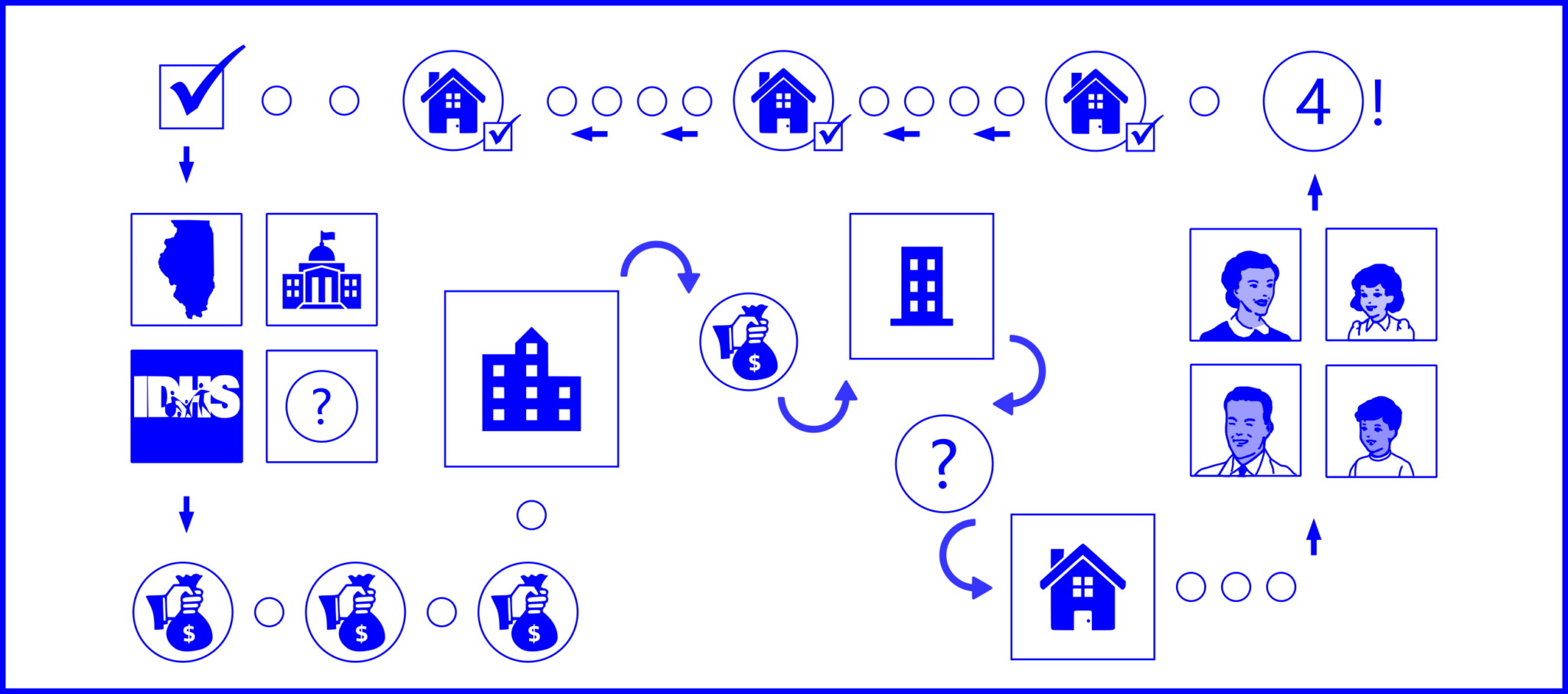In an effort to bolster outreach and encourage participation in the 2020 Census, Governor J.B. Pritzker and the Illinois Department of Human Services (IDHS) made $20 million available to community organizations across the state. Pritzker announced the funding initiative last summer, and—after hiccups early this year—the money was distributed to thirty “regional intermediary” organizations, nine of which are in Chicago.
Each of these regional intermediaries spent a portion of the funding they received on internal operations and outreach, and passed on the rest to dozens of smaller community organizations. The goal of this arrangement was to ensure outreach money reached organizers who were closest to so-called hard-to-count populations—groups of people the U.S. Census Bureau officially recognizes as at risk of being undercounted due to economic and demographic factors, such as language barriers, housing instability, or an undocumented status.
Reaching hard-to-count populations is vital: federal dollars and Congressional representation hinge on Census counts, and undercounting young children, immigrants, people experiencing homelessness, people of color, and other hard-to-count populations puts them at risk of losing both. To help ensure these populations are counted, smaller community organizations can leverage existing relationships with clients and community members.
To understand how the IDHS Census outreach funding moved through Chicago, the Weekly interviewed representatives from each of the city’s nine intermediary organizations—Habilitative Systems Inc., the Illinois Coalition for Immigrant and Refugee Rights, Rincon Family Services, Community Assistance Programs, the YWCA of Metropolitan Chicago, Illinois Action for Children, the Puerto Rican Cultural Center, the University of Illinois at Chicago, and the Pilsen Wellness Center—about how they used the money internally and to how many partner organizations each one had given grants.

Habilitative Systems, Inc. (HSI)
HSI serves communities on the South and West Sides, primarily Austin, West Garfield Park, North Lawndale, and Englewood. IDHS allocated $3,267,500 to the organization, which spent twenty-three percent internally on administrative costs and marketing and outreach, and passed on seventy-seven percent to twenty-nine partner organizations. HSI’s CEO, Donald Dew, told the Weekly that the organization’s focus from the start has been on the “fundamental issue of the social determinants of health.” For example, when COVID-19 hit and HSI began distributing personal protective equipment, they included information packets about the Census with the packages.
Illinois Coalition for Immigrant and Refugee Rights (ICIRR)
IDHS allocated $2,433,500 to ICIRR for use in Chicago. The organization has three separate contracts with the state, which cover its operations in Chicago, the suburbs, and the collar counties, respectively; in total, IDHS allocated $4,839,000 to ICIRR across these three regions. In the city, ICIRR passed on sixty-eight percent of the grant money to partner organizations, and in the suburbs and collar counties it distributed sixty-five and sixty-nine percent, respectively. Across those three regions, ICIRR contracted with sixty-three local organizations. Beyond what it passed on to partner organizations, “fifteen percent of the budgets was dedicated to unified media outreach and printing materials going to subrecipients,” said ICIRR spokesperson Brandon Lee. ICIRR also organized seven car caravans and held phone-banking events in which organizers made over 10,000 phone calls, which resulted in a five percent increase in Census response rates over a single week in Little Village alone, said Maria Fitzsimmons, ICIRR’s Census campaign director.
Rincon Family Services (RFS)
IDHS allocated $1,400,000 to Rincon Family Services, which provides mental health and substance use treatment to communities on the Northwest Side. Rincon’s Census project director, Ruben Feliciano, said fifty-five percent of that budget went to twelve partner organizations. Of the forty-five percent it retained, Feliciano said it was used for outreach activities, organizing events, and interfacing with partner organizations. With the advent of COVID-19, Rincon combined its Census outreach with distributing personal protective equipment to community and essential workers. “We have sought to think outside of the box, [to] ensure that we work with a myriad of stakeholders with the intent of engaging and encouraging as many people to complete their Census,” he said.
Community Assistance Programs (CAP)
IDHS allocated $1,400,000 to CAP, which provides job placement to unemployed and at-risk populations in twenty communities in Chicago and seventeen south suburban areas. The organization passed $1,077,000 of the funding on to fourteen partner organizations. CAP’s CEO, Sheryl Holman, said the organization was “very strategic” about how they distributed funding and closely supervised how partner organizations spent the outreach money allocated to them. “There are a lot more people out there than we thought” who are hard to count, Holman said.
YWCA of Metropolitan Chicago
IDHS allocated $1,310,000 to the YWCA, which concentrated on reaching the LGBTQ+ community and those experiencing homelessness. The organization’s chief equity officer Martina Hone said a “rough breakdown” was that twenty percent was spent on vendors such as a design agency and ad buys, twenty percent was spent in-house on staff and indirect costs, and sixty percent of the grant money went to thirteen partner organizations, When the pandemic occurred, one of YWCA’s partner organizations, One Chicago, redirected its Census outreach efforts to public health instead. To pick up the slack, “we redirected funds to support Streetwise staff and especially vendors who had no market for their newspapers during the COVID-19 crisis,” Hone said. (YWCA acquired Streetwise, a “street magazine” sold by people experiencing or at risk of experiencing homelessness, earlier this year.) “To fill this gap and continue to give vendors the dignity of work, we were able to pay them stipends to serve as Census ambassadors to those experiencing homelessness.”
Illinois Action for Children (IAC)
IDHS allocated $1,108,050 to Illinois Action for Children, which supports access to early care and childhood education. The organization passed fifty-one percent of the funding on to six community-based organizations, and spent forty-nine percent internally. Spokesperson Adam Summers said internal spending went to hiring outreach staff, distributing community outreach materials to partners, and providing data and documentation supports for partners. IAC focused on making sure children ages zero to five—a population that was undercounted in the last Census—are counted in this one, said Choua Vue, the organization’s vice president for community impact.
Puerto Rican Cultural Center (PRCC)
IDHS allocated $301,000 to the Puerto Rican Cultural Center in Humboldt Park. The Cultural Center passed half of the funding on to five partner organizations, and spent half internally on hiring four part-time Census outreach navigators and a full-time Census program director. Jessica Gutiérrez, PRCC’s director of advocacy, policy, and community outreach, said having regional intermediaries bring more community-based organizations to Census outreach among communities that are most affected by undercounting was critical. “It was vital and urgent to have community-based organizations there to provide comfort and understanding and empathy to communities that look like them and trust them as the main communicators of our Census count,” Gutiérrez said.
University of Illinois at Chicago (UIC)
IDHS allocated $248,5000 to UIC. Researchers at its College of Urban Planning and Public Affairs provided data analysis, data visualization, and program evaluation services to help other regional intermediaries track and focus their outreach efforts. (UIC did not pass on any funding to partner organizations; it spent the grant money on hiring graduate assistants and subcontractors.) Kathleen Yang-Clayton, a clinical assistant professor of public administration and one of the project’s principal investigators, said researchers developed an online reporting platform that regional intermediaries and their partners used to record their outreach activities. They also developed a set of strategies and worked with the regional intermediaries “to make sure they had a balanced approach and that they were thinking about places where they could do more one-on-one engagement,” community education, or phone banking, Yang-Clayton said.
Pilsen Wellness Center (PWC)
The Pilsen Wellness Center serves ten predominantly Latinx community areas in Chicago and four in the south and west suburbs. IDHS allocated $148,500 to the organization, which retained forty-nine percent and passed on fifty-one percent to a single partner, SGA Youth and Family Services. Paul Naranjo, the corporate compliance director at Pilsen Wellness Center, said the money kept in-house went to hiring a full-time project manager to oversee Census outreach, as well as outreach and marketing.
Jim Daley is the Weekly’s politics editor. He last reported on public mental health clinics adopting telehealth for service delivery.



